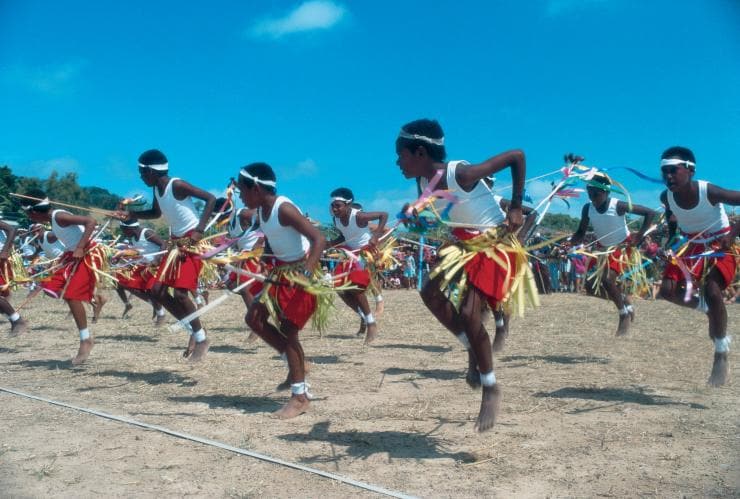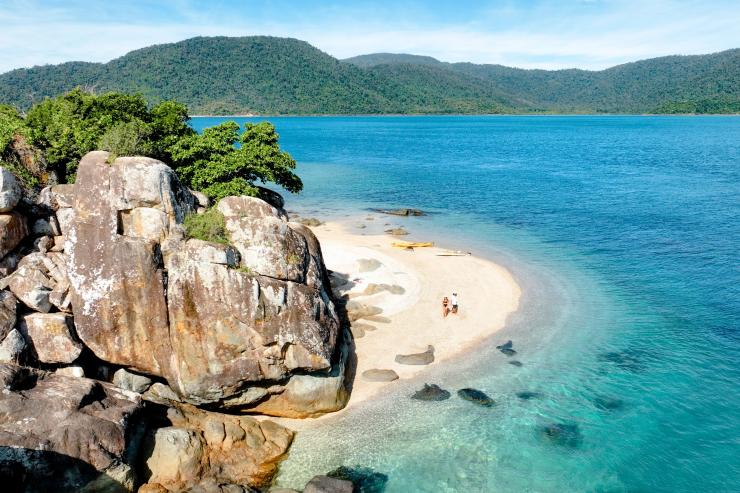
Friday Island, Torres Strait Islands, Queensland © Mark Fitz
5 reasons to visit the extraordinary Torres Strait Islands
The remote islands of Torres Strait are home to a unique Aboriginal culture and a virtually untouched natural environment.
By Lucy Jones
The Torres Strait Islands are a world unto themselves. Almost 300 islands dot the ocean like stepping stones from the northern tip of Cape York to Papua New Guinea. Very few are inhabited – and only a handful permit visitors – but intrepid travellers who venture to Australia’s northernmost outpost will be rewarded with a glimpse into a fascinating culture, stunning landscapes and a slice of history.
This is a cultural crossroads

Torres Strait Cultural Festival, Torres Strait Islands, Queensland © Peter Lik, Tourism and Events Queensland
Two of the oldest cultures on Earth meet in the Torres Strait Islands. Aboriginal Torres Strait Islanders are of Melanesian descent, but have interacted with Aboriginal people from Tropical North Queensland for tens of thousands of years. The result is a rich and vibrant culture with strong traditions of dance, colourful headdresses, masks, carving and printmaking. Each of the islands’ small communities has its own distinct practices, so you’ll discover something new every day. Visit Gab Titui Cultural Centre on Thursday Island to view intricate art from Torres Strait Islander artists.
The fishing is out of this world

Friday Island, Torres Strait Islands, Queensland © Mark Fitz
Whether you throw a line in from the wharf on Horn Island, fish with your feet in the waves on Friday Island or head out into the crystal-clear waters of the Arafura Sea, there’s a fishing adventure for you in the Torres Strait Islands. With minimal commercial fishing in the region, you’ll find fish like coral trout, sail fish, mackerel, golden snapper and red emperor in huge numbers. Throw out your line on your own, or join one of several local fishing tours, including Lax Charters and Tours and Nomad Sportfishing Adventures.
The military history is fascinating

Green Hill Fort, Thursday Island, Torres Strait Islands, Queensland © Mark Fitz
The Torres Strait Islands sit between Australia and the rest of the world, so have long played a role in Australia’s defence. Green Hill Fort on Thursday Island is one of the oldest military fortifications in the country, built between 1891 and 1893 to defend the colony against a potential Russian invasion. More than 5,000 Australian and American personnel were stationed on Horn Island during World War II and the Japanese regularly bombed the island. Almost 900 Torres Strait Islanders volunteered for service here, and Horn Island was the only place in Australia where Aboriginal and non-Aboriginal soldiers served side by side. Gun emplacements, slit trenches, an RAAF airstrip and even a wrecked aircraft remain on the island, a sobering reminder of how close the war came to mainland Australia.
Read next
Australia's most beautiful islands
It’s Australia’s original pearling region

Pearls, Friday Island, Torres Strait Islands, Queensland © Mark Fitz
Commercial pearling in the Torres Strait dates back to the 1870s, predating the industry in Broome by about a decade. Pearling in the region had its ups and downs, but was revived in the 1960s and you can now visit two working pearl farms on the islands. Roko Pearls, on private Roko Island, and Kazu Pearls, on remote Friday Island grow cultured pearls in the warm tropical waters. You can walk over the beds on a floating jetty, see how pearls are harvested and even take home a one-of-a-kind piece of jewellery.
The islands are virtually undiscovered

Friday Island, Torres Strait Islands, Queensland © Mark Fitz
Forget crowds – in the Torres Strait Islands, there’s a good chance you won’t ever see another tourist. Some of that is down to logistics. Only a few of the islands permit visitors, you may need to arrange permits and transport options are limited. But step foot on these picture-perfect islands and that will all be forgotten. Tiny villages lined with leaves and flowers, blissful beaches and laid-back locals are waiting to welcome you to this little slice of paradise.





























































































































